You can’t always get what you want – but if you try sometimes, you might find you get what you need.
– Mick Jagger (1969)
Central banks can’t always get what they want. In fact economic theory illustrates the perils of central banks pursuing what they want – at least sometimes. Seminal research showed how central banks can be tempted to exploit the short-run Phillips curve tradeoff by permitting a higher rate of inflation today in order to push down unemployment temporarily. But such behavior has the consequence of generating higher, self-fulfilling inflation expectations in the future.1 The Great Inflation of the late 1970s and early 1980s in industrialized countries gave stark empirical validation of this lesson. Central banks are now well aware of the "time inconsistency" trap, which is one reason why the predominant focus of central banks today is on keeping inflation under control.
But as Asian countries learned a decade ago, low inflation is not the only thing that central banks need. Inflation was falling in most of the crisis-afflicted countries heading into mid-1997.2 But current account deficits in many countries – abetted by fixed exchange rate regimes – were combined with a build-up of short-term external liabilities. The dramatic reversal of capital inflows accentuated the maturity mismatches and caused the collapse of fixed exchange rate regimes and widespread insolvencies, as many of the corporate and financial sectors’ liabilities were denominated in foreign currencies.
The lessons of the Asian financial crisis could fill several books, and indeed they have.3 Near the top of the list of lessons would be the vulnerability of fixed exchange rate regimes and the necessity of comprehensive financial sector supervision. Also near the top must be the importance of sufficient central bank foreign exchange reserves to provide a liquidity buffer during financial market disruptions. There has been a long-standing debate over whether the Asian crisis was fundamentally a liquidity or solvency event. But substantial academic work suggests that countries with substantial levels of foreign reserves are less vulnerable to financial crises.4
The purpose of this paper is three-fold. The first objective is to review the evolution of the concept of "reserve adequacy" for central bank foreign exchange reserves. The second objective is to show where emerging market countries stand at the present time according to various measures of reserve adequacy, with a focus on the relevance of the reserve adequacy concept today. The final objective is to discuss the costs of – and limits to – reserve accumulation in the current global economic and financial system.
The Evolving Concept of Reserve Adequacy
To assess the concept of reserve adequacy, it is useful to start with why countries hold foreign reserves in the first place. The principal reason is to provide a ready source of liquidity in the event of unforeseen disruptions in the funding of a country’s international balance of payments activities. The availability of foreign reserves enables a country to finance temporarily shortfalls in the balance of payments without large and potentially disruptive changes in the exchange rate or in domestic consumption and investment. Without foreign reserves, for example, a country that suffers a steep decline in the price of its principal export and is unable to arrange exceptional financing would likely face substantial exchange rate depreciation and lower GDP growth in order to keep its trade balance at a level compatible with financing through capital flows. 5 By drawing on its foreign reserves, a country can reduce the impact of balance of payments shocks on the exchange rate and real GDP growth, reducing overall macroeconomic volatility, which in turn generally improves long-run growth prospects by encouraging higher levels of investment that come with greater stability.
The essence of reserve adequacy boils down to the capacity of central bank reserves to act as a buffer in the face of various balance of payments shocks. Economists’ views on what constitute adequate levels of international reserves have therefore evolved with the evolution of the global economic and financial system: as the nature of likely shocks to the balance of payments has changed, so have the metrics for reserve adequacy.
Under the original Bretton Woods system and for a number of years that followed, capital controls remained widespread and capital mobility across borders was limited. Under Bretton Woods, therefore, shocks to the balance of payments came primarily from the trade account, and reserve adequacy was measured in these terms. Specifically, reserves were calculated as a multiple of the months of imports that they could finance, with the typical minimum benchmark being 3 months.
The shortcomings of this concept of reserve adequacy became painfully apparent in the 1990s. With the liberalization of capital controls beginning in the 1980s, cross-border financial flows accelerated dramatically. A rapid reversal in capital account flows became the most significant potential shock to most emerging markets’ balance of payments, leading to the development of several reserve adequacy metrics defined using capital account variables.
The most prominent is the ratio of reserves to short-term external debt, with "short-term" defined as debt amortizations due within the next 12 months (regardless of the original maturity of the obligations). The minimum benchmark of reserves equal to at least 100% of short-term external debt became known as the Greenspan-Guidotti rule. Greenspan-Guidotti is perhaps the single concept of reserve adequacy that has the most adherents and empirical support.6
Other capital account metrics focus on the capacity of reserves to finance capital flight from the local market – that is, sales of domestic securities and their conversion into foreign exchange. This approach recognizes that balance of payments pressures can come not only from scheduled drains on foreign exchange embodied in short-term external debt but also the liquidation of investor positions in local capital markets.
Two examples of domestic capital market-related measures are the ratios of reserves to broad money and reserves to domestic equity portfolio holdings by foreigners. Unlike the months of imports and short-term debt measures, these metrics are stock rather than flow measures.7 The adequacy thresholds for each are intended to reflect the extent to which foreign reserves could finance the outflow that would materialize if a certain portion of the stock of local money or foreign holdings of equity were liquidated and converted into foreign exchange. The minimum threshold for broad money is usually considered 5-20%, with the lower end of the range considered adequate for flexible exchange rate regimes and the latter number for fixed regimes. The threshold for foreign equity holdings is typically considered to be 30%, though in practice actual outflows during crisis events have rarely approached these levels and a fall in equity prices in local-currency terms would reduce the value of the outstanding stock during a crisis.
Other approaches to reserve adequacy also deserve mention. The first is a "value-at-risk" or related "insurance-based" framework.8 The intuition behind this approach is to view shocks to the balance of payments as probabilistic events for which reserves act as insurance. The amount of insurance, or reserves, to hold is the level where the (declining) marginal benefit of holding the insurance equals the (increasing) marginal cost. The actual calculation is done by using empirical data on variations in the balance of payments, assigning "disutility" values for crisis-related outcomes, and introducing a measure for the cost of holding reserves. These approaches are appealing for their theoretical rigor and clear articulation of the basic problem confronting central banks in their decisions about reserve targets. The downside is their complexity, difficulty in assigning "utility" values to various outcomes, and reliance on empirical volatilities. The fact that these approaches are less transparent increases the "black box" factor of their output.
The second is related to the path-breaking and influential Bretton Woods II (BWII) thesis put forward by Michael Dooley, David Folkerts-Landau, and Peter Garber.9 The BWII contention is that exchange rate intervention by emerging market countries to maintain undervalued exchange rates is a rational and sustainable development strategy. The counterpart to such intervention, of course, is the build-up of international reserves by emerging market central banks. The BWII framework argues that such reserves serve literally as "collateral" for foreign investors, inducing them to make foreign direct investments (FDI) in emerging market countries that further advance the development process.
There are several problems with this latter part of the argument. First, in practice central bank reserves have generally been immune to seizure even in the event of sovereign defaults, to say nothing of private investment disputes. Second, the pattern of reserve accumulation (heavy purchases of U.S. assets by Asian countries for instance) does not match the pattern of FDI (which for Asia has largely been intra-regional including from Japan). Third, while reserves-as-collateral has a certain logic for countries with uncertain protections for foreign investors, it is harder to explain for countries that have a long history of foreign investment and protection of property rights. 10 BWII is thus more compelling as a theory for why central banks target the level of the exchange rate rather than as a theory of targeting a specific level of foreign reserves – a distinction we will discuss at greater length below.
For these reasons, we focus in the rest of this paper on the reserve adequacy metrics described above. The next section examines how current reserve levels in emerging markets stack up against these metrics.
Reserve Adequacy Today
It is no secret that reserves in emerging markets have grown at an astonishing pace in recent years.11 Figure 1 tells the story for a selection of countries. Combined reserves of this group almost quadrupled from $720 billion at end-2001 to $2.7 trillion by the first quarter of 2007. China alone accounts for almost half of the increase. But as Figure 1 illustrates, the increase in reserves has been broad-based.
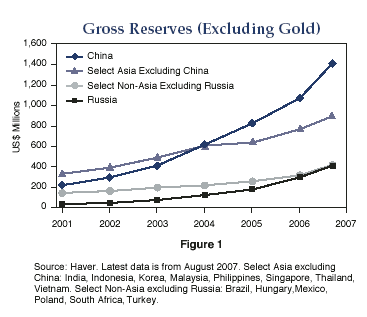
Where do emerging market countries stand with respect to traditional metrics of reserve adequacy? Table 1 provides a summary, using data as of the first quarter of 2007. It is clear from the table that reserves in emerging markets almost across the board are substantially above the minimum thresholds recommended under traditional metrics of reserve adequacy. In fact, the only readings that are below the minimum thresholds on any of the indicators are Turkey’s ratio of reserves to short-term debt (85%) and South Africa’s coverage of foreign equity holdings (22%). The magnitude of above-threshold holdings is also illustrated in Figures 2a-d.
It is also apparent that, in general, reserve coverage in Asian countries is substantially above comparable coverage ratios in non-Asian emerging markets. Table 1 shows the median values for the coverage ratios for Asian and non-Asian countries: 5.6 vs. 3.9 in months of imports, 340% vs. 154% for short-term debt, and 172% vs. 122% of foreign portfolio equity holdings. The median values for coverage of broad money are roughly the same at 30%.
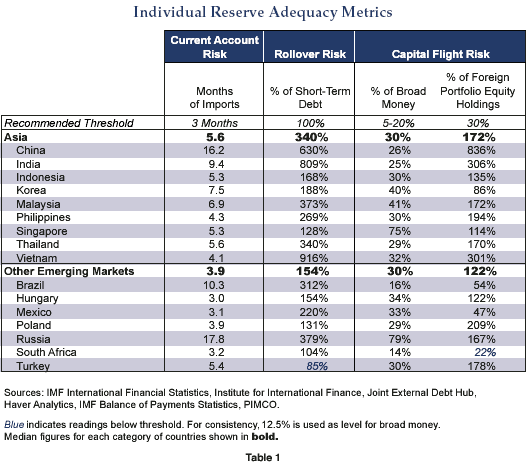
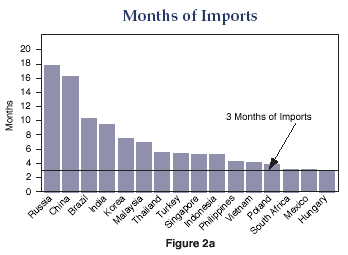
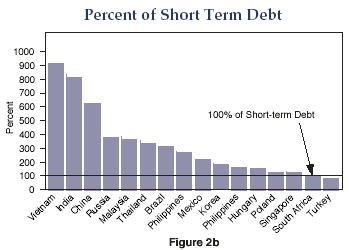
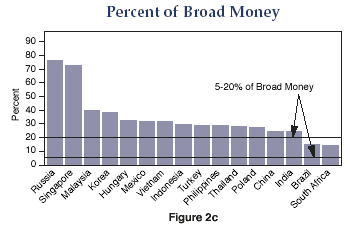
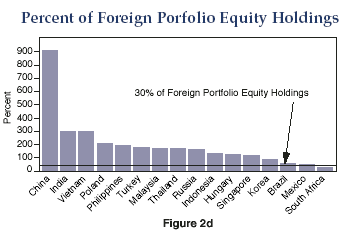
Besides looking at individual indicators, we can also look at indicators that provide a composite picture of reserve adequacy against the variety of risks discussed above. The first column of Table 2 shows reserves as a percentage of the most restrictive minimum reserve adequacy metric for each individual country. For example, for Korea, the most restrictive minimum metric is short-term debt: 100% coverage for short-term debt generates a minimum reserve requirement of $130 billion – larger than $97 billion to cover 3 months of imports, $85 billion to cover 30% of foreign portfolio equity, and $77 billion to cover 12.5% of broad money. Korea’s $244 billion in reserves covered 188% of the $130 billion required to cover short-term debt.
As Table 2 illustrates, all countries except Turkey and South Africa held reserves in excess of the minimum required under the most restrictive standard. At the median, Asian countries held almost twice (186%) the amount of reserves required by the most restrictive standard, while non-Asian emerging markets were slightly above the relevant level (105%).
We can look at an even more extreme measure of reserve adequacy by adding together the minimum thresholds for current account risk (3 months of imports), rollover risk (100% of short-term debt), and capital flight risk (the higher of 12.5% of broad money and 30% of foreign portfolio equity holdings). The results are shown in the second column of Table 2. Russia, China, India, and Malaysia exceed 100% coverage under even this extreme measure of reserve adequacy. The median value for Asian countries again exceeds the comparable value for non-Asian emerging markets.
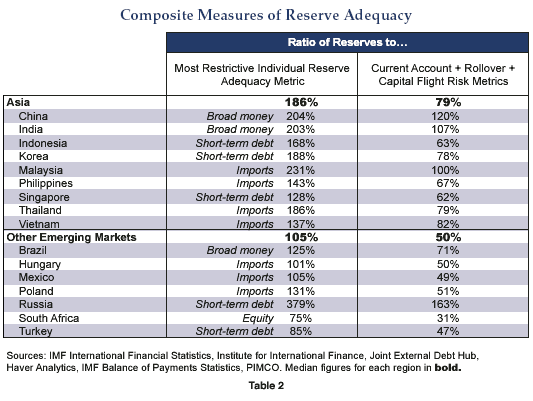
Note that this "combined" measure of reserve adequacy is purely illustrative and lacks any empirical support as a meaningful indicator itself, in contrast to the individual reserve adequacy metrics discussed above. Moreover, several of the countries with lower readings on this measure – particularly in Asia – have large current account surpluses that provide an enormous buffer against outflows on the capital account.12
These data suggest that reserve holdings in emerging markets overall are substantially above those required for crisis-prevention purposes, with "excess" reserves particularly high in some countries. Asian countries as a group have markedly higher levels of reserves relative to standard vulnerability metrics than their counterparts in other regions.
The move in many countries toward more return-oriented strategies for managing their reserves offers some confirmation that central banks recognize this. Putting a portion of reserves into higher-risk assets like fixed-income credit products, equities, and alternative investments reduces portfolio liquidity and increases vulnerability to price declines. The "revealed preference" willingness of central banks and countries to do this suggests that they view overall reserve holdings as comfortably in excess of any plausible prudential requirements.
All of this points to the conclusion that central bank foreign exchange intervention in many emerging markets is being driven not by objectives vis-à-vis reserve accumulation itself. Rather reserve accumulation is the outgrowth of objectives vis-à-vis the exchange rate, as many central banks seek to limit the appreciation of their currencies to encourage export-led growth a la the BWII thesis. The exchange rate dog wags the reserve accumulation tail, not vice versa.13
As such, the very concept of reserve adequacy has lost its meaning for many countries in the emerging world. This is particularly true in Asia. With foreign reserves rocketing upwards as central banks seek to satisfy rising demand for their local currencies, the relevant question with respect to reserve accumulation is no longer "how much is enough?" but rather "how much is too much?" The next section looks more closely at the factors that may set limits on the magnitude of reserve accumulation in the future.
The Limits of Reserve Accumulation
Some of the constraints on unlimited reserve accumulation are well known. To purchase foreign reserve assets, the central bank must finance the purchase either by issuing new liabilities or selling other assets on its balance sheet. With the power of the printing press, the central bank can finance the purchase of foreign reserves interest-free simply by issuing new liabilities in the form of domestic currency. Indeed, this produces seigniorage profits for the central bank. But doing so excessively risks igniting inflation.
On the opposite side, financing reserve purchases via the issuance of central bank debt or sale of assets like domestic government securities – known as sterilization – can prevent the growth of base money. But it entails financial costs for the central bank, either through the interest foregone on the government security assets or the interest the central bank must pay on its own securities. In addition, the central bank may find it difficult to place large volumes of sterilization securities in domestic financial markets, particularly if such markets are still at an early stage of development.
What does recent experience tell us about inflationary risks and sterilization costs? Inflation has generally declined or remained low in emerging market countries in recent years during the period of rapid reserve accumulation. In fact, some countries that have experienced relatively stronger inflationary pressures during recent years have been those with lower levels of reserve coverage levels, such as Turkey, Hungary, and South Africa. This is certainly not universally true, and Russia stands out as an example of a country where rapid reserve accumulation has contributed to high rates of inflation. But in much of Asia, inflation rates have remained relatively low. The recent uptick in inflation has been driven in large measure by supply-side pressures from food and energy prices.
Turning to sterilization, the central bank pays (or foregoes) a domestic financing rate to withdraw liquidity from the local market. It receives interest on the foreign reserves it purchases. If the interest rate paid in the domestic market exceeds the interest rate received on foreign reserves, the central bank incurs an incremental net income cost when it purchases foreign reserves and sterilizes; it earns an incremental net income gain when the cost of domestic financing is lower than the rate earned on foreign reserves. In situations of sterilized intervention, then, overall central bank seigniorage profits are lower than they otherwise would be when domestic interest rates are higher than foreign interest rates, and vice versa.14
The financial costs of sterilizing reserve accumulation do not appear to have been prohibitive to date. Table 3 provides a very simple calculation to compare these costs across countries. The first column shows the domestic financing rate, usually representing the overnight interest rate or the yield on central bank sterilization instruments. Because data on central bank reserve holdings are not widely available, the rate on foreign reserve holdings is assumed to be the yield on the two-year U.S. Treasury note (4.00%). The second column shows the "carry" on each central bank’s foreign reserve holdings, with a negative number indicating the cost to the central bank of holding foreign reserves. The third column shows the annual profit or loss from the interest rate carry on the central bank’s entire reserve holdings. The fourth column shows the annual profit or loss from the interest rate carry on the central bank’s excess reserve holdings, defined as the amount of reserves over and above the minimum under the most restrictive standard described in the previous section.
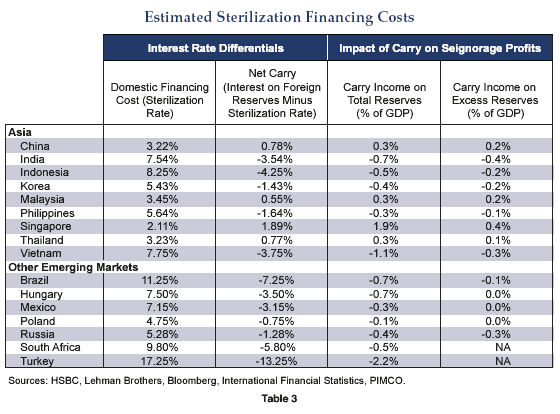
The carrying costs of excess reserve holdings do not appear particularly significant. All are less than 0.5% of GDP. In several Asian countries, the central bank earns a carry profit because of the low costs of domestic financing for the central bank. This does not, however, account for foreign exchange valuation changes.
From experience to date, it would be difficult to make the case that inflationary pressures or sterilization costs have presented significant obstacles to reserve accumulation. This does not mean that they will not do so in the future. Indeed, central banks’ monetary policies must increasingly contend with possible second-order inflationary spillovers to non-commodity prices from supply shocks – a task that is complicated by the monetary effects of reserve accumulation.15 In the remainder of this section, however, we focus primarily on several other factors that act as limits on reserve growth.
Asset bubbles. The dramatic rally in emerging market equities this fall has resulted in a wave of renewed press speculation about a possible bubble in these assets. These concerns are not new, having been voiced at numerous points during the run-up in emerging market equity prices since 2003. Certainly there are fundamental reasons for the strength of emerging market equities, including increasing confidence about the durability of their growth prospects and (until recently at least) lower price-to-earnings multiples than their counterparts in industrialized countries.
But history provides sobering lessons about how asset valuations can become stretched beyond what even strong fundamentals justify, when financial conditions are permissive. Foreign exchange intervention by central banks tends to boost domestic asset prices in two ways: first, by generally easing domestic financial conditions as interventions are only partially sterilized; and second, by inducing even larger inflows into local markets by investors who believe they will benefit from eventual currency appreciation as the central bank relents in its efforts to maintain an undervalued level. This is a reason that central banks should not take excessive comfort from relatively restrained consumer price inflation: it might be because loose liquidity conditions resulting from rapid foreign exchange accumulation are showing up in the prices of assets rather than goods.
Japan’s experience in the late 1980s and early 1990s has become a fascinating empirical counterpoint to this discussion. Ronald McKinnon and others have argued that Japan’s mistake was to submit to pressure from the United States and other countries to allow yen appreciation, which was followed by more than a decade of deflation in Japan. Larry Summers and others have responded that Japan’s mistake was to pursue an easy monetary stance in the late 1980s aimed at limiting yen appreciation, which produced enormous real estate and equity bubbles. The size of these bubbles meant that when they popped, the depth and velocity of the decline created a discontinuous change that made successful stabilization much more difficult.16
It is true – as Alan Greenspan has argued – that during a period when asset prices are growing rapidly it is difficult to distinguish between the fundamental factors driving such changes versus financial causes/investor euphoria associated with asset bubbles that will eventually pop. But for a central bank that is concerned about macroeconomic stability, policy decisions must incorporate serious consideration of the latter possibility. 17 When there are strong theoretical and empirical reasons to believe that exchange rate policy contributes to excess asset price increases, a prudent central bank may wish to phase down its foreign currency intervention before such pressures build up to the point of painful and disorderly reversal.
Central bank balance sheet losses. A number of analysts have pointed out that the foreign asset holdings of central banks are subject to large mark-to-market losses in local currency terms when local exchange rates appreciate. These mark-to-market losses could amount to multiples of central bank capital, resulting in negative net worth in the absence of recapitalization by the country’s finance ministry. 18
Does it matter? Some studies have shown that countries with financially weak central banks tend to experience higher rates of inflation, since the institutional independence of the monetary authorities is compromised. 19 But there are also examples of central banks with negative capital (such as Chile) with no apparent impact on inflation.
In general, the flow situation facing the central bank on its income statement is more important to monetary control than the mark-to-market stock situation on its balance sheet. That is, if the central bank is paying out more in interest on its sterilization instruments than it is receiving on its foreign reserves, it is forced to either (a) emit more money each month, with possible inflationary consequences, or (b) issue additional sterilization instruments to prevent base money from growing, which simply increases the central bank’s interest burden further. The central bank thus becomes conflicted between inflation-fighting objectives and its own financial health. In extreme situations, this can result in a profound erosion of public faith in the central bank’s inflation-fighting credibility, resulting in an upward spiral of inflationary expectations, interest rates, and central bank losses.
As the exchange rate appreciates, the central bank’s income situation deteriorates because the interest earnings on foreign reserves become less valuable in local currency terms. For example, for a country in which foreign reserves are equal to 25% of GDP and interest income on foreign reserves equals 1% of GDP, each 10% of currency appreciation reduces central bank income by 0.1% of GDP. Though the direct effect is modest, these costs build up over time as reserves grow, the currency appreciates, and domestic sterilization financing rates increase as central banks tighten policy.
A final comment on this balance sheet topic: it is sometimes argued that a secondary rationale for holding foreign reserves is to provide a stock of assets that can be used for recapitalizing a weak domestic banking sector. The shortcoming of this argument is that when the local exchange rate is under pressure to appreciate, this makes foreign assets less valuable over time – possibly much less valuable. In such a situation, it would be preferable to build a stock of domestic currency-denominated assets that can be used for bank recapitalization.
Excess dependence on foreign demand. Currency intervention to maintain depreciated exchange rates is a vehicle for promoting export-led growth, along the lines proposed by Bretton Woods II. Indeed, the net export contribution to growth in emerging markets has been consistently positive in recent years, as illustrated in Figure 3. On a net basis, therefore, emerging markets have relied more on strong demand growth in industrialized countries than the other way around. Domestic consumption in emerging markets has fallen as a percentage of GDP, as shown in Figure 4.
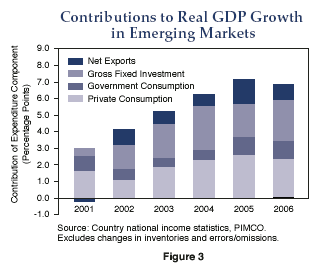
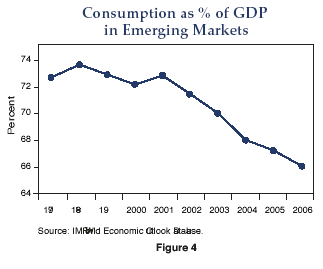
The resilience of emerging market growth – and that of the global economy as a whole – would be enhanced by more diversified sources of global demand. While global economic growth has remained strong amid the slowdown in the United States, part of the reason is that much of the drag on U.S. real GDP growth has come from demand for non-tradeables especially residential investment. A sharper and broader contraction in the United States would present greater risks to the global economy.
Parts of the non-industrialized world – particularly oil exporters – have substantially ramped up their demand for imports and thus their contribution to net global demand. For Asian countries, the scope for increasing domestic aggregate demand is considerable, both through additional fiscal spending in some countries and further exchange rate appreciation. This entails an evolution of the export-driven growth model that has guided economic policy in the region in recent years. The danger is that if countries resist such an evolution for too long, they miss the opportunity to facilitate a smooth hand-off from slower demand growth in the United States and other industrialized countries.
Political limits. The current account deficits in the industrialized world – the flip side of the current account surpluses and reserve accumulation in the emerging world – raise questions not only of economic sustainability but also political sustainability. This is most apparent in the United States, where momentum is building in the U.S. Congress for legislation aimed at the foreign exchange and trade policies of other countries.
Several bills have been approved in Senate and House committees that would tighten the definition of currency "manipulation" or "misalignment" by U.S. trading partners. The enforcement provisions of the bills could allow U.S. companies to use currency undervaluation as grounds for anti-dumping duties and could compel the U.S. government to file a complaint against such countries with the World Trade Organization (WTO). For example, the Dodd-Shelby Senate Banking bill would compel the U.S. Treasury to designate a country as a currency manipulator if it (1) has a material global current account surplus, (2) has a significant bilateral trade surplus with the United States, and (3) is engaged in prolonged one-way currency market intervention.
Although these bills remain a long way from becoming law (among other reasons because of a crowded U.S. legislative calendar and opposition from the Bush Administration), the direction of the political winds is clear. Pressure is likely to build further heading into the 2008 Presidential election year, especially if the U.S. economy weakens. And it is not just the United States. Criticism in Europe of Chinese foreign exchange policy has intensified, culminating in a recent call by European finance ministers for an official dialogue with China on exchange rate policy. While the renminbi has been appreciating gradually against the U.S. dollar, it has depreciated against the euro as the dollar has weakened. The new multilateral emphasis is reflected in the recent G7 Finance Ministers statement, which called for "accelerated appreciation of [China’s] effective exchange rate."
At the same time, on the investment side of the ledger, apprehension is growing in many industrialized countries regarding investments by state-owned entities from other countries including sovereign wealth funds (SWFs). Examples include U.S. Congressional resistance to the purchase of Unocal by the China National Offshore Oil Company (CNOOC) in 2005 and of port facilities in the United States by Dubai Ports World in 2006. Both transactions were ultimately withdrawn.
In response to the Dubai Ports deal, the U.S. Congress has strengthened its oversight of the Committee on Foreign Investment in the United States (CFIUS), which has the power to prevent purchases of U.S. companies by foreign entities on national security grounds. Under the new legislation, purchases by foreign state-owned companies are automatically subject to CFIUS investigation. Again, the United States is not alone in moving in this direction. German chancellor Angela Merkel recently said that her government was considering legislation to make it more difficult for sovereign wealth funds to purchase German companies. The European Union has also discussed such measures, with particular emphasis on prospective purchases by Russia.
Thus the rapid rate of reserve accumulation in emerging markets faces political constraints from two fronts: on the trade side, from legislation targeting the exchange rate policies that have produced increasing levels of foreign reserves; and on the investment side, as countries are seeking to diversify and boost returns on their reserve assets. While there is nothing imminent in legislation that would break apart the current system, the progressive ratcheting up of the political pressure is rightly viewed as a constraint on future reserve growth.
Conclusion
The financial crises of the 1990s and early 2000s justifiably increased the focus of policymakers on economic stability, in addition to economic growth. The proliferation of metrics to measure the adequacy of foreign reserve holdings was an outgrowth of this emphasis on insulating countries from the disruptive effects of financial crises.
With reserve holdings in most emerging markets now comfortably above the levels suggested by broadly accepted adequacy metrics, attention rightly shifts to other potential sources of instability. As argued here, some of that potential instability may in fact come from the rapid pace of reserve accumulation itself, by contributing to imbalances in asset markets, central bank finances, global aggregate demand, and the political consensus on economic policy. The greatest risk is that this combination of imbalances continues to grow over time, culminating in sudden and disorderly changes in emerging markets and the global economy.
That scenario is by no means certain or even the most likely. The best insurance against such an outcome involves continued rebalancing of global demand. This will likely involve a fiscal expansion in some countries, particularly those with low levels of debt and strong fiscal positions. A mix of import-intensive infrastructure investment combined with targeted social investments can both boost productivity and increase the incentives for households to consume.20
It will also entail appreciation of emerging market currencies and a concomitant moderation in the pace of reserve accumulation. Given the focus on exchange rate policies favoring export-led growth in recent years, this is not necessarily a recipe for central banks getting everything they want. But it might be one for getting what they – and the global economy – need.
Paul McCulley
Managing Director
Ramin Toloui
Senior Vice President
*Prepared for the 2nd Meeting of EMEAP Monetary and Financial Stability Committee, Bali, Indonesia, November 2, 2007.
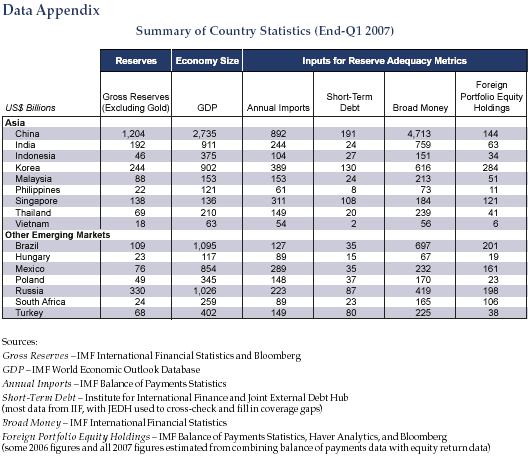
1 Robert Barro and David Gordon (1983), "A Positive Theory of Monetary Policy in a Natural Rate Model," Journal of Political Economy, vol. 91, pp. 589-610.
2 Although this is true, inflation rates had been higher than those of trading partners, which produced substantial real exchange rate appreciation due to fixed nominal exchange rates.
3 For a scholarly example, see Morris Goldstein (1998), The Asian Financial Crisis: Causes, Cures, and Systemic Implications, Institute for International Economics. For a general audience example, see Paul Blustein (2001), The Chastening, Public Affairs.
4 For example, see Matthieu Bussiere and Christian Mulder (1999), "External Vulnerability in Emerging Market Economies: How High Liquidity Can Offset Weak Fundamentals and the Effects of Contagion?" IMF Working Paper WP/99/88, July.
5 Adjustment is generally accomplished through reductions in domestic absorption (consumption plus investment) known as "expenditure reduction" and through the shifting of absorption to goods produced domestically rather than abroad known as "expenditure switching."
6 See J. Onno de Beaufort Wijnholds and Arend Kapteyn (2001), "Reserve Adequacy in Emerging Market Economies" IMF Working Paper WP/01/143, September.
7 Although short-term debt is frequently referred to as a stock, it is analytically more properly thought of as a pre-programmed flow during a specified period of time, specifically the next 12 months.
8 See for example, Olivier Jeanne and Romain Ranciere (2006), "The Optimal Level of International Reserves for Emerging Market Countries: Formulas and Applications" IMF Working Paper WP/06/229, October; Pablo Garcia and Claudio Soto (2006), "Large Hoardings of International Reserves: Are They Worth It?" in External Vulnerability and Preventative Policies ed. Ricardo Caballero; Jung Sik Kim, Ramkishen Rajan, et. al. (2005), "Reserve Adequacy in Asia Revisited: New Benchmarks Based on the Size and Composition of Capital Flows" unpublished working paper, January; and Jaewoo Lee (2004), "Insurance Value of International Reserves: An Option Pricing Approach" IMF Working Paper WP/04/175, September.
9 For the original argument, see Michael Dooley, David Folkerts-Landau, and Peter Garber (2003), "An Essay on the Revived Bretton Woods System," National Bureau of Economic Research, Working Paper 9971, September. For the latest comprehensive discussion, see Michael Dooley, Peter Garber, and David Folkerts-Landau (2007), "The Two Crises of International Economics," National Bureau of Economic Research, Working Paper 13197, June.
10 While it is hard to make the case for reserves as literal collateral, high levels of reserve holdings certainly do encourage capital inflows and help reduce the cost of capital for borrowers from that country, sovereign and otherwise. But this is primarily because (1) they reduce the risk of financial crisis and macroeconomic volatility and (2) growing central reserve levels are a signal that private financial markets have excess demand for the local currency at the prevailing exchange rate, presaging future currency appreciation that investors seek to take advantage of. Only the first of these, however, provides a target for the adequate >level of reservesper se – and those targets should look like the reserve adequacy measures discussed above, which provide guidance on levels necessary to avert crisis and reduce volatility. The second factor is instead a statement about the level of the exchange rate – in which case, maintaining an undervalued exchange rate attracts capital inflows. When the level of the exchange rate is primary, the amount of reserve accumulation is secondary and simply a consequence of the central bank’s objectives with respect to exchange rate.
11 For a recent broad-based study, see European Central Bank (2006), "The Accumulation of Foreign Reserves" ECB Occasional Paper Series No. 43, February.
12 Some governments – such as Singapore – also have very large positive net external asset holdings outside of the central bank. Thus, reserve adequacy measures understate the financial wherewithal of the sovereign.
13 In addition to the BWII literature, see Joshua Aizenman and Jaewoo Lee (2007), "Financial versus Monetary Merchantilism: Long-Run View of Large International Reserves Hoarding" unpublished working paper, February.
14 Note that this does not account for the currency mismatch on the balance sheet, which can produce valuation gains or losses driven by exchange rate movements – a topic we discuss in greater detail below. For a study of sterilization costs, see MS Mohanty and Philip Turner (2006), "Foreign Exchange Reserve Accumulation in Emerging Markets: What are the Domestic Implications?" BIS Quarterly Review, September.
15 Central banks have increasingly turned to reserve requirements as another tool for reducing the liquidity impact of reserve accumulation. While hikes in reserve requirements restrain credit creation by reducing the multiplier from base money, they do so by passing the costs along to the banking sector since the increase in required reserves is often unremunerated. This can impair the health of the banking sector, retard financial development, and encourage disintermediation with potential negative productivity effects for the economy as a whole.
16 For an introduction to this debate, see Ronald McKinnon (2005), "China’s New Exchange Rate Policy: Will China Follow Japan into a Liquidity Trap," Wall Street Journal, October, and Larry Summers (2007), "History Holds Lessons for China and its Partners," Financial Times, February 25. An online debate about the topic can be found at http://blogs.ft.com/wolfforum/2007/02/history_holds_l.html.
17 Indeed, as Greenspan has recently said, the Fed hikes in 2004 were aimed partly at cooling the skyrocketing housing prices in the United States. Greenspan argues that they failed to do so because (ironically in the context of this paper!) foreign central bank buying of U.S. Treasuries kept long-term U.S. rates low despite the Fed increases of the short rate.
18 Russell Green and Tom Torgerson (2007), "Are High Foreign Exchange Reserves in Emerging Market A Blessing or a Burden?" U.S. Treasury Occasional Paper No. 6, March.
19 See Peter Stella (1997), "Do Central Banks Need Capital?" IMF Working Paper WP/97/83, July; Peter Stella (2002), "Central Bank Financial Strength, Transparency, and Policy Credibility" IMF Working Paper WP/02/137, August; and John Dalton and Claudia Dziobek (2005), "Central Bank Losses and Experiences in Selected Countries" IMF Working Paper WP/05/72, April.
20 While it is true that fiscal contraction(raising government savings) is often recommended to help sterilize the monetary consequences of foreign exchange intervention, a policy mix of exchange rate undervaluation combined with fiscal austerity serves to exacerbate the over-dependence on external demand. A policy mix of exchange rate appreciation combined with fiscal expansion where circumstances allow can help achieve a better balance between internal/external demand and help offset the contractionary impulse of exchange rate appreciation. Such an approach is most appropriate for countries where current account surpluses are driving sustained reserve accumulation, rather than instances in which short-term capital inflows are the key factor, in which cases fiscal contraction can play a role in sterilizing intervention and averting economic overheating.
